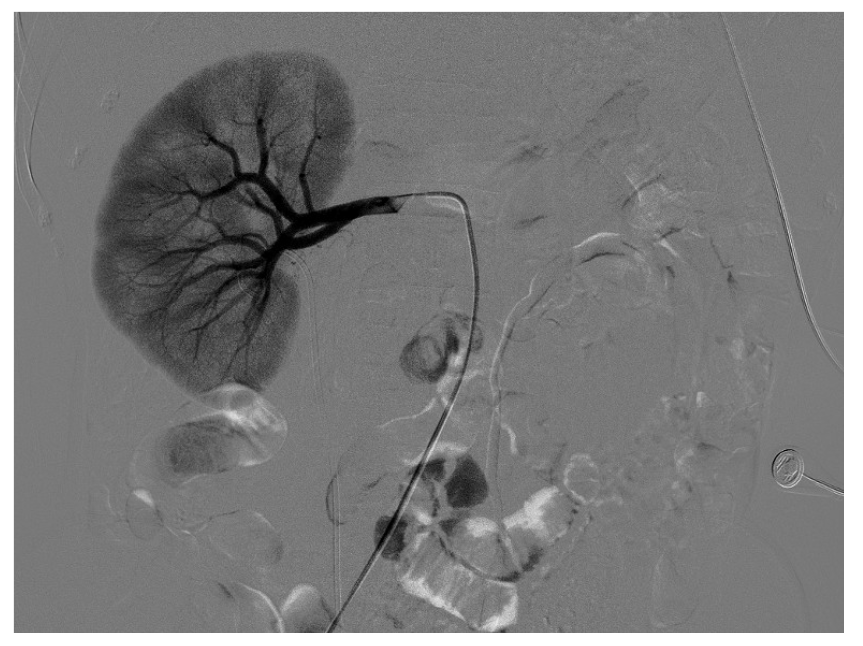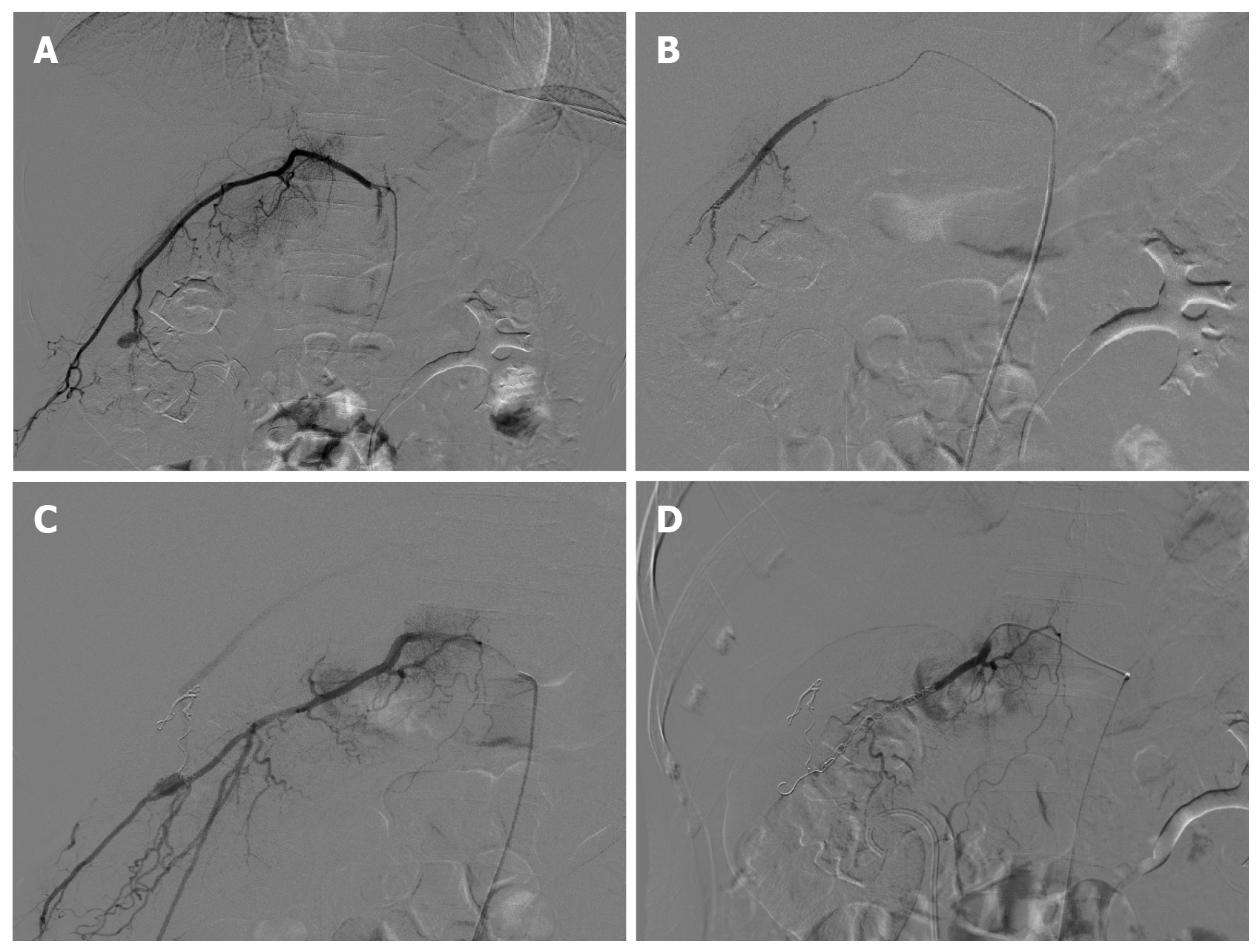Published online Nov 26, 2020. doi: 10.12998/wjcc.v8.i22.5790
Peer-review started: August 21, 2020
First decision: September 13, 2020
Revised: September 21, 2020
Accepted: October 1, 2020
Article in press: October 1, 2020
Published online: November 26, 2020
Processing time: 96 Days and 12.5 Hours
Lumbar artery bleeding is an uncommon complication of percutaneous nephrolithotomy (PCNL). This report presents a rare complication where two lumbar arteries were injured by a single puncture following PCNL. Only scarce reports of this complication have been reported.
A 24-year-old man presented with a 2.2 cm right renal calculus, which was managed by PCNL. During nephrostomy tube removal on the 6th postoperative day, intense bleeding was observed in the fistula and the catheter. Renal angiography was undertaken immediately; however, an initial selective renal angiogram revealed no evidence of renal vascular injury. One of these injuries involved a pseudoaneurysm from a peripheral branch in the first right lumbar artery, while the other involved an arteriovenous fistula from a peripheral branch in the second right lumbar artery. Subsequently, coil embolization was performed successfully.
This case is being reported to inform clinicians that lumbar artery damage is one of the causes of severe bleeding after PCNL and could involve damage of more than one artery.
Core Tip: Lumbar artery bleeding is an uncommon complication of percutaneous nephrolithotomy (PCNL). This report presents a case where the bleeding of two lumbar arteries was caused by one puncture following PCNL. Radiological imaging revealed pseudoaneurysm and arteriovenous fistula as the two injuries. This case is being reported to inform clinicians and interventional radiologists that lumbar artery damage is one of the causes of severe bleeding after PCNL, and could involve damage of more than one artery. Angiography and embolization should be performed patiently and carefully to avoid underdiagnosis or missed diagnosis.
- Citation: Liu Q, Yang C, Lin K, Yang D. Bleeding of two lumbar arteries caused by one puncture following percutaneous nephrolithotomy: A case report. World J Clin Cases 2020; 8(22): 5790-5794
- URL: https://www.wjgnet.com/2307-8960/full/v8/i22/5790.htm
- DOI: https://dx.doi.org/10.12998/wjcc.v8.i22.5790
Percutaneous nephrolithotomy (PCNL) is a common treatment option for upper urinary tract calculi. However, severe vascular complications [pseudoaneurysm, arteriovenous fistula (AVF) and arterial laceration] are reported in 0.3%-4.7% of the cases[1], and most complications generally affect the kidneys. Lumbar artery bleeding following PCNL is uncommon. This report presents a rare complication where two lumbar arteries were injured; one affected by pseudoaneurysm and the other by arteriovenous fistula. These injuries were caused by a single puncture following PCNL. To the best of the authors’ knowledge, this is the first report on this complication. Institutional review board approval is not needed for case reports at the authors’ institution.
A 24-year-old man presented with a 2.2 cm right renal calculus, which was managed by PCNL. During nephrostomy tube removal on the 6th postoperative day, intense bleeding was observed in the fistula and the catheter.
A 24-year-old man presented with a 2.2 cm right renal calculus, which was managed by PCNL. A 6-F ureteric catheter was introduced transurethrally under general anesthesia. A three-way Foley catheter was then inserted into the bladder. The patient was placed in a prone position, and the middle calyx was punctured under sonographic guidance. Using a guidewire, dilatation was performed with 8-F and 11-F dilators. Finally, a 20-F sheath was positioned, and a holmium laser lithotriptor with continuous irrigation was inserted into the sheath. After the completion of PCNL, a 20-F nephrostomy tube was inserted.
Slight postoperative bleeding, lasting for 5 d, was observed in the nephrostomy tube. No significant change in the hemoglobin level was observed during re-examination. During nephrostomy tube removal on the 6th postoperative day, intense bleeding was observed in the fistula and the catheter; a Vaseline gauze was packed into the fistula. Bladder irrigation was performed immediately. The patient was laid on the bed, and about five minutes later, the bleeding stopped. After about 24 h, extensive bleeding occurred through the catheter again.
The patient had a free previous medical history.
The patient had a free personal and family medical history.
After bleeding, the patient’s temperature was 36.6 °C, heart rate was 92 bpm, respiratory rate was 19 breaths per minute, blood pressure was 130/88 mmHg and oxygen saturation in room air was 98%. Extensive bleeding flowed through the catheter.
Blood analysis revealed a 1.3 g/dL drop in the hemoglobin level after the first intense bleeding.
Renal angiography was undertaken immediately; however, an initial selective renal angiogram revealed no evidence of renal vascular injury (Figure 1). Thereafter, upon reviewing the aortogram and previous literature, lumbar arterial branch injury was suspected. After adjusting the catheter’s position several times, a lumbar arteriogram revealed pseudoaneurysm from a peripheral branch in the first right lumbar artery located along the nephrostomy tract (Figure 2A). Embolization was then performed using a 4 mm × 14 mm coil. A subsequent angiogram confirmed the successful exclusion of the pseudoaneurysm with a preserved flow in the main trunk of the lumbar artery (Figure 2B).
To avoid any missed diagnoses, the second right lumbar arteries were examined by angiography. Surprisingly, an arteriovenous fistula was detected from a peripheral branch in the second right lumbar artery located along the nephrostomy tract (Figure 2C). Subsequently, coil embolization was performed with two 4 mm × 14 cm coils. The final angiogram demonstrated successful exclusion of the arteriovenous fistula (Figure 2D).
The final diagnosis of the presented case is lumbar artery hemorrhage following PCNL.
Coil embolization was performed successfully for both lumbar arterial branches.
Post-embolization, the patient had no further episodes of bleeding and was discharged in a stable state. Two weeks after the surgery, the double J stent was removed during cystoscopy in the outpatient setting. One month after the procedure, the patient was advised to undergo a routine inspection to confirm the absence of after-effects and adverse reactions.
Severe hemorrhage following PCNL remains a rare but troublesome problem faced by urologists. Renal arteriography is a highly effective way of detecting the bleeding points with pseudoaneurysm, AVF and arterial laceration being the most common findings. Superselective renal artery embolization (SRAE) has been proven to be an effective and a life-saving procedure in more than 90% of such cases[2]. However, in rare cases, the procedure fails, requiring repetitive SRAE sessions or an open operation[3]. When the need for either arises, it is likely to present a challenge for urologists, interventional radiologists and healthcare providers.
When SRAE reveals no positive findings, we should suspect injury of the other arteries that are located along the nephrostomy tract. Bleeding of the lumbar artery due to PCNL is a rare occurrence and may be missed on renal arteriography. El Tayeb et al[4] reported that there were no cases of lumbar artery injury among the 0.48% (16/3338) of the kidneys requiring angioembolization. Srivastava et al[5] retrospectively analyzed 1854 patients who underwent PCNL and reported that 27 (1.4%) of these required angiography and/or embolization for bleeding control; among these, only one had a lumbar artery injury.
We report the present case where two lumbar arteries were injured by one puncture following PCNL resulting in significant bleeding. One of these injuries involved a pseudoaneurysm from a peripheral branch in the first right lumbar artery, while the other involved an AVF from a peripheral branch in the second right lumbar artery. A review of literature did not reveal any related articles. Previous research[4] has shown that arterial pseudoaneurysm causes intermittent bleeding and is more common than AVF. Clot formation at variable intervals and intermittent ruptures when an artery is injured are characteristic of arterial pseudoaneurysm. Unlike pseudoaneurysm, AVF occurs when a paired set of artery and vein is injured, leading to the passage of blood from the injured artery to the adjacent injured vein. It presents with continuous bleeding because the vein is ruptured due to the unbearable pressure exerted by the direct entry of the arterial system into the venous system[6]. In the present case, there was no significant bleeding within the first 5 d after the surgery. Probably, the injured arteries were oppressed by the nephrostomy tube.
The findings indicated that all arteries on the access tract can be injured. This case is being reported to inform clinicians that lumbar artery damage is one of the causes of severe bleeding after PCNL and could involve damage of more than one artery. Therefore, angiography/embolization should be performed carefully and patiently to avoid any missed diagnosis and mistreatment.
Manuscript source: Unsolicited manuscript
Specialty type: Radiology, nuclear medicine and medical imaging
Country/Territory of origin: China
Peer-review report’s scientific quality classification
Grade A (Excellent): 0
Grade B (Very good): 0
Grade C (Good): C
Grade D (Fair): 0
Grade E (Poor): 0
P-Reviewer: Goel A S-Editor: Zhang H L-Editor: Filipodia P-Editor: Wang LYT
| 1. | Kyriazis I, Panagopoulos V, Kallidonis P, Özsoy M, Vasilas M, Liatsikos E. Complications in percutaneous nephrolithotomy. World J Urol. 2015;33:1069-1077. [RCA] [PubMed] [DOI] [Full Text] [Cited by in Crossref: 59] [Cited by in RCA: 77] [Article Influence: 7.0] [Reference Citation Analysis (0)] |
| 2. | Vignali C, Lonzi S, Bargellini I, Cioni R, Petruzzi P, Caramella D, Bartolozzi C. Vascular injuries after percutaneous renal procedures: treatment by transcatheter embolization. Eur Radiol. 2004;14:723-729. [RCA] [PubMed] [DOI] [Full Text] [Cited by in Crossref: 47] [Cited by in RCA: 46] [Article Influence: 2.1] [Reference Citation Analysis (0)] |
| 3. | El-Nahas AR, Shokeir AA, El-Assmy AM, Mohsen T, Shoma AM, Eraky I, El-Kenawy MR, El-Kappany HA. Post-percutaneous nephrolithotomy extensive hemorrhage: a study of risk factors. J Urol. 2007;177:576-579. [RCA] [PubMed] [DOI] [Full Text] [Cited by in Crossref: 165] [Cited by in RCA: 190] [Article Influence: 10.6] [Reference Citation Analysis (0)] |
| 4. | El Tayeb MM, Knoedler JJ, Krambeck AE, Paonessa JE, Mellon MJ, Lingeman JE. Vascular complications after percutaneous nephrolithotomy: 10 years of experience. Urology. 2015;85:777-781. [RCA] [PubMed] [DOI] [Full Text] [Cited by in Crossref: 23] [Cited by in RCA: 28] [Article Influence: 2.8] [Reference Citation Analysis (0)] |
| 5. | Srivastava A, Singh KJ, Suri A, Dubey D, Kumar A, Kapoor R, Mandhani A, Jain S. Vascular complications after percutaneous nephrolithotomy: are there any predictive factors? Urology. 2005;66:38-40. [RCA] [PubMed] [DOI] [Full Text] [Cited by in Crossref: 138] [Cited by in RCA: 155] [Article Influence: 7.8] [Reference Citation Analysis (0)] |
| 6. | Djuimo M, Aubé M, Beland M, Jeldres C, Carmel M, Benko A. Lumbar Artery Pseudoaneurysm: A Complication of Percutaneous Nephrostomy. Urol Case Rep. 2017;13:66-68. [RCA] [PubMed] [DOI] [Full Text] [Full Text (PDF)] [Cited by in Crossref: 1] [Cited by in RCA: 1] [Article Influence: 0.1] [Reference Citation Analysis (0)] |










